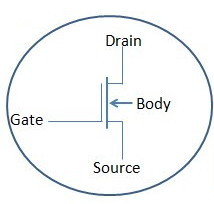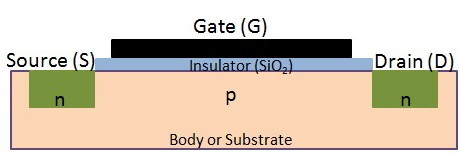| << Chapter < Page | Chapter >> Page > |
Arguably the most important invention of modern times, the transistor was invented in 1947 at Bell Labs by John Bardeen, William Shockley, and Walter Brattain. The result of efforts to replace inefficient and bulky vacuum tubes in current regulation and switching functions. Further advances in transistor technology led to the field effect transistors (FETs), the bedrock of modern electronics. FETs operate by utilizing an electric field to control the flow of charge carriers along a channel, analogous to a water valve to control the flow of water in your kitchen sink. The FET consists of 3 terminals, a source (S), drain (D), and gate (G). The region between the source and drain is called the channel. The conduction in the channel depends on the availability of charge carriers controlled by the gate voltage. [link] depicts a typical schematic and [link] the associated cross-section of a FET with the source, drain, and gate terminals labeled. FETs come in a variety of flavors depending on their channel doping (leading to enhancement and depletion modes) and gate types, as seen in [link] . The two FET types are junction field effect transistors (JFETs) and metal oxide semiconductor field effect transistors (MOSFETs).



Junction field effect transistors (JFETs) as their name implies utilize a PN-junction to control the flow of charge carriers. The PN-junction is formed when opposing doping schemes are broght together on both sides of the channel. The doping schemes can be made to be either n-type (electrons) or p-type (holes) by doping with boron/gallium or phosphorus/arsenic respectively. The n-channel JFETs consists of pnp junctions where the source and drain are n-doped and the gate is p-doped. [link] shows the cross section of a n-channel JFET in the “ON” state obtained by applying a positive drain-source voltage in the absence of a gate-source voltage. Alternatively the p-channel JFET consists of npn junctions where the source and drain are p-doped and the gate is n-doped. For p-channel a negative drain-source voltage is applied in the absence of a gate voltage to turn “ON” the npn device, as seen in [link] . Since JFETs are “ON” when no gate-source voltage is applied they are called depletion mode devices. Meaning that a depletion region is required to turn “OFF” the device. This is where the PN-junction comes into play. The PN-junction works by enabling a depletion region to form where electrons and holes combine leaving behind positive and negative ions which inhibit further charge transfer as well as depleting the availability of charge carriers at the interface. This depletion region is pushed further into the channel by applying a gate-source voltage. If the voltage is sufficient the depletion region on either side of the channel will “pinch off” the flow through the channel and the device will be “OFF”. This voltage is called the pinch off voltage, V P . The n-channel V P is obtained by increasing the gate-source voltage in the negative direction, while the p-channel V P is obtained by increasing the gate-source voltage in the positive direction.

Notification Switch
Would you like to follow the 'Physical methods in chemistry and nano science' conversation and receive update notifications?